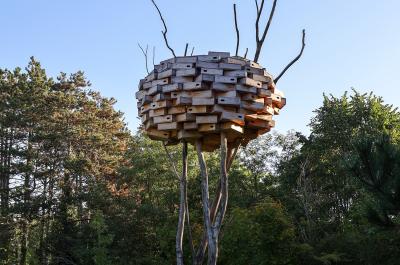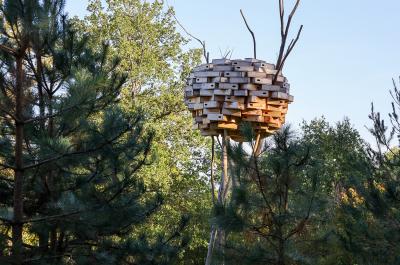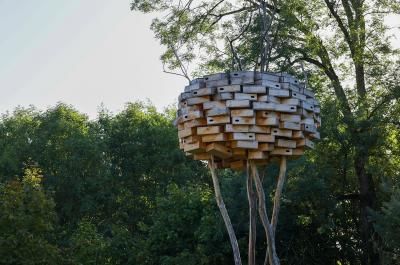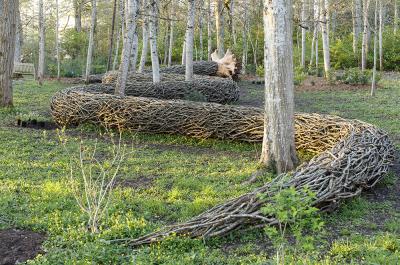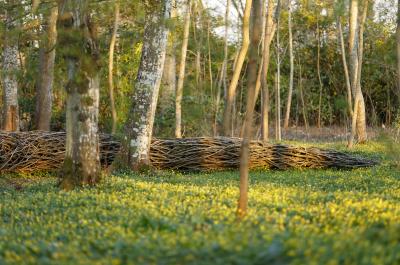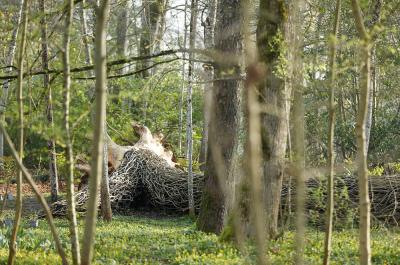14. Bob Verschueren
"Le clan des voltigeurs" et “Chemin de vie”

Bob Verschueren uses natural elements as his means of expression. Basing his work on plant life from the sites involved, he transforms trees, branches, leaves and so on into spectacular sculptures evocative both of the splendour and deliquescence of all living things. Each piece continues a reflection on human beings, their lives and deaths, and on the connection they maintain with their natural environment.
“In the great majority of cases, the materials used are basically waste. The transition from being “nature” to being “garbage” is one of the central points in my reflections. I regard all the work involved as a sort of initiatory journey, where nature gives me real lessons in philosophy, lessons about life”.
“Each has the value of metaphor rather than symbol. I don’t want to encapsulate my installations in obligatory unequivocal interpretations. I prefer to leave them open to different interpretations by their beholders, each with their own sensibilities and experience. I seek to provide them with something of the character of an event. When an installation resonates with its host site, it seems self-evident, creating tension between is timelessness and its ephemeral character,” the artist states.
Le clan des voltigeurs, 2023
This new installation at the Domain brings together 250 parallelepipeds, most of which are nesting boxes for swifts, a rare species in danger of extinction, at the “top” of three branches, positioned vertically like a bouquet.
Chemin de vie, 2020
Amid the undergrowth, a sort of serpent emerges from a tree stump. It slithers between the surrounding trees before completing its journey by plunging back down into the ground with one last bound. Its journey recalls the path of a tree, which comes from the earth and returns to the earth.
BIOGRAPHICAL NOTES


A Belgian artist known and exhibited across the world, a creator of countless exhibitions whose body of work is the subject of numerous catalogues, Bob Verschueren belongs to the environmental art movement, which includes such artists as Nils-Udo and Andy Goldsworthy and follows on from Land Art. Indoor and outdoor installations, wind painting, light painting, phytogravure, sequential works in which time acts on perishable materials – the artists maintains a very close relationship with nature and matter, time and space. His artistic practice goes hand-in-hand with ecological and philosophical reflection that gives it remarkable consistency. His interventions on a wide range of sites (railway stations, churches, museums, brownfields, art galleries and out in the countryside) feature branches, tree stumps, mosses, vegetables, mushrooms, coffee grounds, ears of wheat, terracotta pots, flour, natural pigments, stones and pebbles, and tell stories as fascinating as they are ephemeral, filled with strange beauty and power.
Bob Verschueren is a self-taught visual artist born in Etterbeek in Belgium in 1945. He began his artistic career in the late 1960s, starting out as a painter. In 1978, he turned to Land Art, creating wind paintings, natural pigments spread across the landscape by the wind, and light paintings, a photographic technique that fixes light by placing a light source in front of the lens. In the 1980s, he decided that he would no longer use anything but natural materials, plant life in particular. Since then, he has created over 300 installations in Europe and the rest of the world.
For each of his works, Bob Verschueren ensures that the site’s architecture, nature, and the selected materials are in perfect harmony. Removed from their natural settings, most of the components gathered are bound to decay. Hence, he persistently questions the unbreakable link between life and death. He also explores other areas, including sound (Catalogue de plantes, begun in 1995), engraving (Phytogravures, begun in 1999), photography and frottage. For him, a piece of wasteland, a forest or an exhibition venue all become areas for experimentation.
Several of his most recent works are perennial. For example, in Brussels, at the Erasmus House and the Jardin des Visitandines, two installations have been designed as calls to meditation within the city walls. Invited more than once by France’s Annecy Paysages art festival, Bob Verschueren has created several pieces for the event, three of which are on show all year round and bear witness to recent developments in his work. Composed of 10 trees assembled two by two and planted in the earth with their roots in the air, La Haie d’honneur straddles a path in the city’s Jardins de l’Europe. The work is a tribute to dead trees as well as an encouragement to city dwellers to celebrate nature. L’Arbre pourfendu, on the other hand, alludes to the depth of the philosophical tales by Italo Calvino (Le Vicomte pourfendu), an author dear to Bob Verschueren’s heart. A bare trunk is speared by a flimsy young tree. Is this a renewed quarrel between ancient and modern? To the surrealism of the scene, the artist adds the epic tale of mythological battles in which trees, like human beings, measure themselves against each other. The third, Implantations, is an extraordinary piece of architecture, a kind of treetop village for birds: a tree whose branches support miniature houses huddled against one another. The artist treats birds like a human community and provides them with a magical utopian city.
Bob Verschueren is a member of the Royal Academy of Belgium, in the Fine Arts division.
